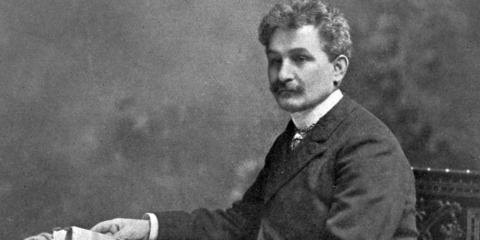MCO’s Sonatas for Violin & Piano can be heard via live stream on Thursday 16 July at Melbourne Digital Concert Hall.
Leoš Janáček (1854-1928)
Sonata for Violin and Piano JW VII/7
The Czech composer Leoš Janáček (1854-1928) stands alongside his countrymen Smetana and Dvořák in reputation. John Tyrrell writing in Grove Music Online describes him as “one of the most substantial, original, and immediately appealing opera composers of the 20th century”.
Many of his large-scale works were produced in the last two decades of his life. His operas Katya Kabanova, The Cunning Little Vixen, The Makropoulos Affair, and The House of the Dead, and works such as the Sinfonietta and the Glagolitic Mass, remain firmly in the repertoire. He composed a considerable amount of choral and chamber music.
Janáček commenced work on the Violin Sonata in 1914 and returned to it intermittently from 1916 to 1922. It had its first performance in April 1922. The work is in four movement and moves through some interesting and surprising tonal landscapes: the movements are in D-flat minor, E major, E-flat minor, and G-sharp minor.
The opening Con moto starts with a striking solo violin passage. The movement is in a modified sonata form and is marked with a contrast of passion and lyricism. Throughout, the piano evocates the sound of the cimbalom with the ripples and arpeggiations. The Ballada was composed in 1914 and published separately. When Janáček returned to the sonata this became the second movement. The tender and lyrical melody is placed over a rippling piano accompaniment. The Allegretto is a scherzo in three sections, with the outer sections providing a contrast to the swirling violin lines of the middle section. The final Adagio is rhapsodic in character and takes us through an array of emotions, tensions and experiences with an overriding sense of desolation.
Fritz Kreisler (1875-1962)
Three Viennese Dances
Fritz Kreisler was born Vienna in 1875 and died in New York in 1962. While he composed operettas, vocal and piano music he is most remembered for his works for violin and piano. He himself was one of the great violin virtuosos of the first half of the twentieth century.
In 1991, John Rockwell in an article in The New York Times observed “that as a composer Kreisler often played works of his own in the latter part of a program or as encores. For a time, in that innocent era before musicologists ruled our lives, he passed off some of those compositions as recently discovered manuscripts by composers famous (Beethoven) to not so famous (Pugnani). Others were unashamedly his own and tended toward Viennese nostalgia and cheerfully virtuosic transcriptions.”
Harold Schonberg writing in 1962 in The New York Times said: “He would have been the last to claim that his Liebesleid, Liebesfreud, Schön Rosmarin, and Caprice viennois were tremendous intellectual contributions to music. But they are as good as anything written in that genre, they have given great pleasure to millions, and they will be played as long as there are violinists who can lift a bow.”
The Three Viennese Dances were composed in 1905 and originally attributed to Joseph Lanner and published as Alt-Wiener Tanzweisen (Old Viennese Dances). The dances are remarkable miniatures vthat capture the changing moods and sound of Vienna at the start of the twentieth century. Their titles set the mood.
Johannes Brahms (1833-1897)
Sonata No 3 for Violin and Piano in D minor Op 108
The German composer Johannes Brahms (1833–1897) spent the summers of 1886–1888 in Thurn in Switzerland. During these sojourns he composed the Violin Sonatas Nos 2 and 3, C minor Piano Trio, Second Cello Sonata, Choral Songs Op 104, and the Double Concerto, as well as other works.
The Third Violin Sonata was premiered in 1889 in Budapest and dedicated to Hans von Bülow. Unlike the first two sonatas it is in four movements, the others being in three. Even with the additional movement this is perhaps his most compact and concentrated sonata.
The opening Allegro is in sonata form and opens with a lyrical main theme against the syncopated rhythms of the piano providing a sense of urgency throughout. The main ideas are shared between the violin and the piano. The Adagio is an endearingly gentle and romantic aria with a slow waltz quality. The piano is reduced to the role of an accompanist. The Un poco presto e con sentimento provides a great contrast to the Adagio. Here the piano takes the focus with the violin providing a simple accompaniment. The final Presto agitato is a virtuosic display for the two instruments. The frenzied tarantella character marks the movement throughout. Within are short interludes of calm and reprieve among the storms of the movement.
© David Forrest 2020

